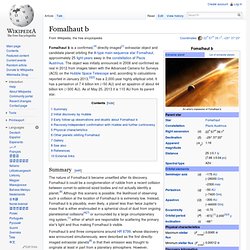

Stars and planetary systems in fiction. The planetary systems of stars other than the Sun and the Solar System are a staple element in much science fiction.

Overview[edit] The notion that there might be inhabited extrasolar planets can be traced at least as far back as Giordano Bruno who, in his De l'infinito, universo e mondi (On the Infinite Universe and Worlds, 1584), declared that "There are then innumerable suns, and an infinite number of earths revolve around those suns, ... [These worlds are inhabited] if not exactly as our own, and if not more nobly, at least no less inhabited and no less nobly.
"[1] Allusions to inhabitants of other stars' planetary systems remained rare in literature for some centuries thereafter. Planetary romances[edit] The fictional genres that appear in the list below include films, television serials, interactive games, and print (among others). General uses of star names[edit] List of planetary systems in fiction[edit] 36 Ophiuchi[edit] 40 (ο²) Eridani[edit] 70 Ophiuchi. 70 Ophiuchi is a binary star system located 16.6 light years away from the Earth.

It is in the constellation Ophiuchus. At magnitude 4 it appears as a dim star visible to the unaided eye away from city lights.[1] Binary star[edit] The primary star is a yellow-orange main sequence dwarf BY Draconis variable[3] of spectral type K0, and the secondary star is an orange main sequence dwarf of spectral type K4.[2] The two stars orbit each other at an average distance of 23.2 AUs.
But since the orbit is highly elliptical (at e=0.499), the separation between the two varies from 11.4 to 34.8 AUs, with one orbit taking 83.38 years to complete.[11] History[edit] This star system was first cataloged by William Herschel in the late 18th century in his study of binary stars. Claims of a planetary system[edit] In 1855, Capt.
Refining planetary boundaries[edit] The negative results of past studies does not completely rule out the possibility of planets. Proxima Centauri. Coordinates: 14h 29m 42.9487s, −62° 40′ 46.141″ Proxima Centauri (Latin proxima, meaning "next to" or "nearest to")[12] is a red dwarf about 4.24 light-years from the Sun, inside the G-cloud, in the constellation of Centaurus.[13][14] It was discovered in 1915 by Scottish astronomer Robert Innes, the Director of the Union Observatory in South Africa, and is the nearest known star to the Sun,[11] although it is too faint to be seen with the naked eye (apparent magnitude 11.05).

Its distance to the second- and third-nearest stars, which form the bright binary Alpha Centauri, is 0.237 ± 0.011 ly (15,000 ± 700 AU).[15] Proxima Centauri is very likely part of a triple star system with Alpha Centauri A and B. Observation[edit] In 1951, American astronomer Harlow Shapley announced that Proxima Centauri is a flare star. Because of Proxima Centauri's southern declination, it can only be viewed south of latitude 27° N.
Fomalhaut b. Fomalhaut b is a confirmed,[4] directly-imaged[1] extrasolar object and candidate planet orbiting the A-type main-sequence star Fomalhaut, approximately 25 light-years away in the constellation of Piscis Austrinus.

The object was initially announced in 2008 and confirmed as real in 2012 from images taken with the Advanced Camera for Surveys (ACS) on the Hubble Space Telescope and, according to calculations reported in January 2013,[2][3] has a 2,000-year highly elliptical orbit. It has a periastron of 7.4 billion km (~50 AU) and an apastron of about 44 billion km (~300 AU).
As of May 25, 2013 it is 110 AU from its parent star.
AOE. Personal Development.